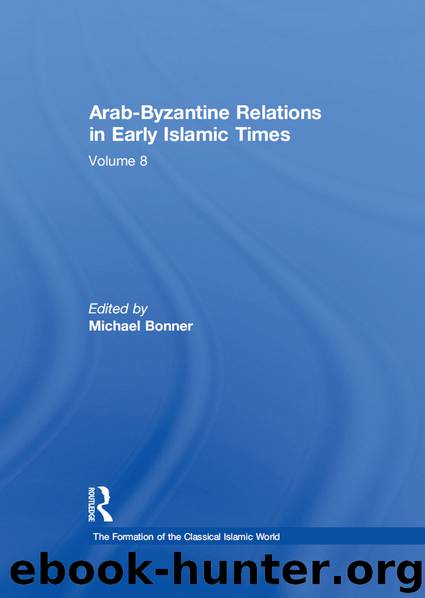Arab-Byzantine Relations in Early Islamic Times by Michael Bonner

Author:Michael Bonner
Language: eng
Format: epub
Publisher: Taylor and Francis
Published: 2017-09-08T00:00:00+00:00
Notes
1 Paul J. Alexander, “Medieval apocalypses as historical sources”, AHR 73 (1968), pp. 998–9, 1002, 1008.
2 E.g. A. A. Vasiliev, “Medieval ideas of the end of the world: east and west”, Byzantion 16 (1942–3), pp. 471–6 and the works dted therein; cf. also S. P. Brock, “Syriac views of emergent Islam”; in G. A. H. Juynboll ed., Studies … (Carbondale, 1982), p. 19.
3 L. Conrad notes how Steinschneider, Goldziher, Casanova and Abbott, though they used and discussed “historical” apocalypses in their writings, “seem to have found little of historical merit in them”. “Portents of the hour: hadith and history in the first century A.H.”, typescript, p. 11 and nn. 48–51 (forthcoming in Der Islam).
4 W. Madelung, “Abd Allah b. al-Zubayr and the Mahdi”, JNES 40 (1981), pp. 291–306; idem “The Sufyani between tradition and history”, SI 63 (198 6), pp. 4–48; idem, “Apocalyptic prophecies in Hims in the Umayyad age”, JSS 31 (1986), pp. 141–86; M. Cook, “Eschatology, history and the dating of traditions”, typescript; L. Conrad, art. cit. and letter to me on 9 May 1989.
5 As demonstrated by both L. Conrad, p. 22 and M. Cook, pp. 10–25, concerning the belief that the Byzantine final malhama would be led by Tiberius, son of Justinian II.
6 W. Madelung, “Apocalyptic prophecies…”, art. cit., 180; L. Conrad’s letter; and even the usually highly sceptical M. Cook in a concluding note, art. cit., pp. 33–4, concerning the applicability of Schacht’s method for dating traditions in this field.
7 E.g. Conrad and Cook on the issue of the final Byzantine malhama, noted above; Conrad on a certain Byzantine–Muslim truce referred to in the tradition on the “six portents of the hour”; and a few other related issues brought up in Madelung’s review of Ḥimṣī apocalyptic traditions.
8 Noted only briefly by M. Cook, art. cit., nn. 63, 93, 116.
9 L. Conrad, art. cit., 11 nn. 53–6 referring to: Nu‘aym b. Ḥammād, K. al-Fitan, Ms. British Museum, Or. 9449, fols, 7(b)–8(a), 11(a–b); Bukhārī, Ṣaḥiḥ (Beirut, 1981), 4/68; Ibn Ḥanbal (d. 241 H.), Musnad (Cairo, 1313 H.), 2/174, 5/228, 6/22, 25, 27; Ibn ‘Asākir, Tārīkh (Damascus, 1951). 1/222–4.
10 Compare also with Nu‘aym, 138(b); Ibn Abī Shayba (d. 235 H.), Mufannaf, (Bombay, 1983), 15/104–5; Abū ‘Ubayd (d. 224 H.), Gharlb al-Hadīth (Haydarabad, 1967), 2/85–7; Ibn Māja (d. 275 H.), Sunan (Cairo, 1 953). 2/134–2. 1371; Ṭibarānī (d. 360 H.), al-Kiu‘jam al-Kabīr (Baghdad, 1984), 18/40–2, 54–5, 64, 66, 79–81; idem, al-Mu‘jam al-Awsaṭ (Riyad, 1985), 1/67–8; Ibn Manda (d. 395), Kitāb al-Īmān (Beirut, 1985), 2/914–16; al- Hākim (d. 405 H.), Mustadrak, (Beirut, 1986), 4/419, 422–3, 551–2; Bayhaqī (d. 458 H.), al-Sunan al-Kubrā, (Haydarabad, 1356 H.), 9/223, 10/248; Wāsiṭī, Faḍā’il al-Bayt al-Muqaddas, (Jerusalem, 1979), 52–3; Ibn al- Murajjā, Faḍā’il Bayt al-Maqdis, Ms. Tūbingen 27, fol. 17 (a–b); piyā’ al-Dīh (d. 643 H.), Faḍā’il Bayt al-Maqdis (Beirut, 1985), 70; al-Muttaqī al-Hindī, Kanz al-‘Ummāl, in the margin of Ibn Ḥanbal, 6/11; Ibn Kathīr (d. 774 H.), al-Nihāya (Cairo, 1980), 1/81–4, 86–9; Qurṭubī (d. 671 H.), Tadhkira (Cairo, 1986), 2/312–14, quoting Marj al-Baḥrayn by Abū al-Khaṭṭāb b.
Download
This site does not store any files on its server. We only index and link to content provided by other sites. Please contact the content providers to delete copyright contents if any and email us, we'll remove relevant links or contents immediately.
| Africa | Americas |
| Arctic & Antarctica | Asia |
| Australia & Oceania | Europe |
| Middle East | Russia |
| United States | World |
| Ancient Civilizations | Military |
| Historical Study & Educational Resources |
Goodbye Paradise(3458)
Men at Arms by Terry Pratchett(2686)
Tobruk by Peter Fitzsimons(2380)
Arabs by Eugene Rogan(2198)
Pirate Alley by Terry McKnight(2130)
Borders by unknow(2121)
Belonging by Unknown(1735)
It's Our Turn to Eat by Michela Wrong(1595)
The Biafra Story by Frederick Forsyth(1563)
Botswana--Culture Smart! by Michael Main(1487)
The Source by James A. Michener(1460)
A Winter in Arabia by Freya Stark(1449)
Gandhi by Ramachandra Guha(1437)
Coffee: From Bean to Barista by Robert W. Thurston(1422)
Livingstone by Tim Jeal(1396)
The Falls by Unknown(1374)
The Shield and The Sword by Ernle Bradford(1316)
Africa: Altered States, Ordinary Miracles by Richard Dowden(1296)
Egyptian Mythology A Fascinating Guide to Understanding the Gods, Goddesses, Monsters, and Mortals (Greek Mythology - Norse Mythology - Egyptian Mythology) by Matt Clayton(1278)
